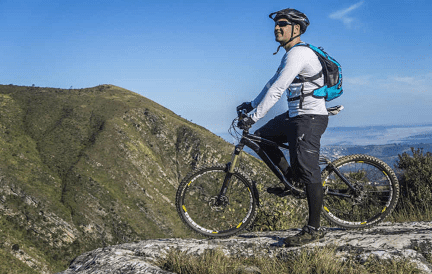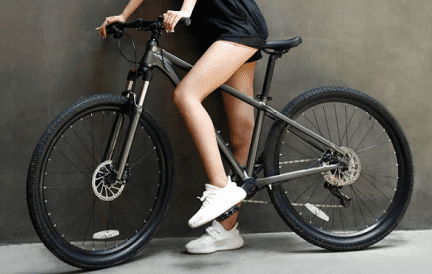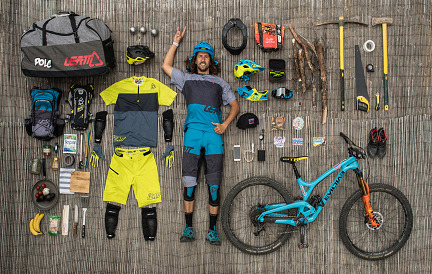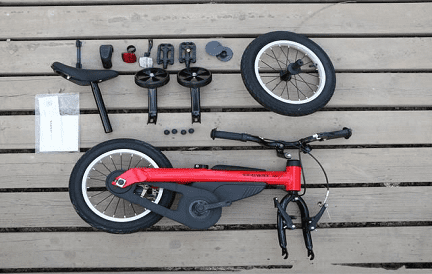When you’re riding down the mountain at high speeds, one obstacle that can get in your way is mud being flung up into your face or equipment. Here is why every mountain biker should buy an mtb Mudguard and what’s the best way to do it.
- Part 1: Why MTB Mudguards are Essential
- Part 2: Buying Guide
- Part 3: Recommended Products
- Part 4: Selection Guide
- Part 5: FAQs
Part 1: Why MTB Mudguards are Essential
When you are mountain biking, one of the most dangerous conditions to face is riding in the wet. The trails become extra dangerous due to wet leaves, slippery rocks, decaying wood, and worst of all mud.
The problem with mud is that it creates risky conditions for the trail and your bike. Nothing could be more distracting or dangerous than letting loose wet debris, fly around while you’re biking down the trail.
The mud can catch on your visor, causing you to slip and lose control. The mud could also jam up your gears or wheels and cause an accident as well. Whether you’re new to the sport, or a seasoned professional, having the best mtb mudguard for your bike and the trails you frequent is incredibly important to keep you and your bike safe.
mtb Mudguards, also called mtb fenders, mtb face fenders, and mtb mud flaps, best mtb front mudguard are made to reduce the amount of debris that sprays off your front wheel. Owning this product will not only make sure you stay cleaner and drier on the trail, but it could one day save your life.

Part 2: Buying Guide
Now that you’re in the market for an mtb mudguard, there are a couple of things you need to know before you buy. First of all, depending on how new or trained you are in mountain biking, your budget for an mtb mudguard could vary.
If you’re new, it’s always a good idea to go for a middle of the road product that is good for a wider range of conditions and won’t break the bank. However, if this isn’t your first rodeo, read this article carefully so you can spend your money wisely and buy the cool mtb mudguards for your bike.
What Makes a Good mtb Mudguard
The best mtb mudguards should be able to stand up to the rigorous conditions of mountain biking, while also not adding too much weight. This is why you’ll find that most mtb mudguards are made from 100% plastic.
The Right Wheel Size
Depending on the trails you’re riding or the mountain bike you own, the wheels and tires you have on can greatly differ. Because of this simple fact, not every mtb mudguard is made for every mountain bike. Before you go and purchase an mtb mudguard online or in-store, you should know the diameter of your wheels as well as the thickness of your tires.
Some mtb mudguards are narrower than others due to their features and the way they are designed to deflect mud. Having the mtb mud flap be too narrow could cause your wheels to damage the mudflap or at the very least, cause a very annoying noise throughout your ride.
Not only do you need to know the diameter of your wheels, but also the distance from the wheel to where the mtb mud flap would be installed. Depending on the design, the mtb mudguard could dip down too low into your tires, causing damage in this way as well.
For this reason, the best thing you can do is take your mountain bike to your local shop. Working with experts in person can help you be sure that you’re buying the right product for your needs while also letting a professional install it for you.
The Various Materials Used in mtb Mudguards
The majority of mtb mud flaps are made with a plastic called polypropylene. This material is cheap, light, and easy to manufacture. While it is becoming increasingly common for brands to only use 100% recycled plastic, it is not the case everywhere.
Some mudguards are made of other materials such as metal. These can add unnecessary weight and not be as flexible as plastic models. These products are usually older in design.
The Size of the mtb Mudguard Matters
Just like shoes, mtb mudguards come in various shapes and sizes. Typically speaking, the longer and wider your mudguard is, the better. However, depending on your wheel and tire size, you may want a shorter mudguard.
How Easy is the Install Process
The install process is more important than it may seem. If you’ve ever built your own furniture, you know that it is easy to put together can make a huge difference with having clear instructions and products that .
With hundreds of models of mtb face fenders out there, you can instal these products onto your mountain bike in many different ways.
Velcro
This is probably the most common version of mtb mudguards you will see. This is a great option for when you want to remove the mtb mudguard frequently when you don’t need it or want to swap it out for something else.
Velcro is incredibly common for these products because they are incredibly adjustable, and the straps are easy to replace if there is damage. Even though Velcro doesn’t always mean high-quality in most industries, here it can be. If you see an mtb mudguard that you like and it has Velcro, it might be the perfect one for you.
Zip-Ties
mtb mudguards with zip-ties are also quite common. Similar to Velcro, mtb mudguards that use zip-ties are highly adjustable and easy to take off when you want to remove the gear. While some products have been known to shift a little more when using zip-ties, this is rare and can be easily fixed with a new set of zip-ties.
Additionally, zip-ties offer a replaceable component advantage that Velcro doesn’t have. You can find high-quality zip-ties in large quantities for very little money. Further, some manufacturers and websites suggest that you can turn any mtb mudguard into a zip-tie mtb mudguard by drilling a couple of well-placed holes. For this reason, mtb mudguards with zip-ties are a bit more accessible and better for mountain bikers who are constantly making changes to their bike or gear.
Nuts and Bolts
This is the strongest form of mtb mudguards. This form factor without a doubtis going to be the most reliable option. However, there are some downsides. First of all, the install process can be tricky. Some products come with their own tools and screws. This can mean that losing a screw or the tool can mean it’s hard to repair the product in the future and may mean you have to fully replace the product.
Part 3: Recommended Products
While we will get into more products in Part 4 of this article, we wanted to outline our favorite products below.
Best mtb Mudguard for your Money
Brand: Mucky Nuts MugGuard
This product is made from 100% recycled plastic. The Mucky Nuts MugGuard is also available in two sizes, a 400 mm Short model and a 600 mm Long model. The product weighs about 85g. The manufacturer claims that the MugGuard is tough and flexible, even after repeated use, twisting, and stamping.
The Mucky Nuts MugGuard is a great value because it fits all wheel sizes and tires up to 3 inches (when used with a boost fork). The MugGuard features a short forward-facing lip that is designed to drive back even the worst sprays and debris.
One unique feature that reviewers like is that the bridge attachment point is recessed, which allows for maximum clearance over the tires. Further, the MugGuard features a wider than average upper arm that protects the seals on your bike.
Pros:
Simple to install and good quality material
The Forward Lip work well
Meant for all wheel sizes, varies on tires.
Cons:
The mudguard is a bit short and may not be best for year-round use. (short model only)
A High-Quality mtb Mudguard
Brand: Mojo DFender Mudguard
This mtb mudguard is not only a great quality product, but it is one of the more stylish options there. While many mudguards use Velcro or zip-ties, this product takes a unique approach and uses a clamp to attach to your mtb. The clamp can be easily secured with a built-in adjuster, meaning no need for tools or extra zip-ties in your pack.
The clamp is designed to be adjusted in a matter of seconds. Although the clamp isn’t a universal design meant for all bike forks, there are several adapters out there that are widely available online. Before buying this product, it is best to check with the Mojo website where they have information and customer support that can get you the information you need.
While the Mojo DFender mudguard is not made of metal, the company ensures that after rigorous testing, the mudguard is always able to bounce back to its original shape. This mudguard is incredibly flexible and durable, the best product for rough conditions.
Aside from being easy to install, this mudguard performs incredibly on the trail. Because of the high-quality clamping mechanism, the mtb mud flap barely wobbles or rubs against the tires or bike when used.
The most important feature of this mtb mudguard is that it has an incredibly wide gate. Due to the width of this mudguard, you can expect ample protection from any mud or debris you may face on the trail. All things considered, this mudguard has amazing performance and is well worth the money.
Pros:
Quick and reliable installation, no extra parts needed
Amazing protection from mud and trail debris
High-quality material that is durable and flexible.
Cons:
Does not work with every bike, adapters required
More expensive than other products
An mtb Mudguard that will Last
Brand: AMS Mud Guard
The AMS Mud Guard is based on a standard design called the “Mashguard”. While this type of mtb Mudguard is common, the AMS branded mudguard offers incredible quality and reliability. Cutting the AMB Mud Guard from a single sheet of plastic, unlike many injection mold built models. This means that the product is slightly thicker than most, being 1.2mm thick and slightly heavier at 36g. This causes the AMB Mud Guard to be incredibly durable.
While this product can handle a lot of wear and tear, it is somewhat shorter than other models. For this reason, it is not the best product to use in extremely wet and muddy conditions. If you are a mountain biker that wants a low-profile mudguard to not ruin the aesthetic of your bike, then this option is perfect for providing a good amount of protection from the elements.
The AMS Mud Guard is attached to the bike with 4 zip-ties, so it is quite easy to install. This guard is designed to cover the fork seals to increase the life of your seals and provide enough protection to stop the majority of mud and trail debris from hitting you.
Even though this is a smaller than average product, this model comes in 18 different designs. This lets you choose a mudguard that has a low profile or one to match your bike already and add some flair.
Pros:
Simple to use
Great price, extremely affordable option
Cool designs to match almost any aesthetic
Cons:
Provides less protection than other mtb mudguards
Best Mudguard for the Worst Conditions
Brand: CRUD XL Fender
This mtb mudguard is a new design that features high-tech solutions to some common mountain biking problems. This mudguard features a tool-free installation process that claims it is compatible with any type of bike suspension fork.
The features of CRUD XL Fender mudguard:
The clamp works by using 6 heavy-duty O-rings that are stretched around the bike fork legs and looped back onto the mudguard. Further, the arms of the fender are protected with a neoprene coating that mitigates some of the effects of wear and tear on the product and the bike.
This mudguard used by high-caliber materials and engineered to an exciting degree. However, because of all these perks, the mudguard is quite heavy, weighing in at 195g. Despite its above average weight, the mudguard is sure to stay in place and not wobble.
This mudguard has stood up even to the most rigorous of tests. After heavy use, reviewers claim that the product has not cracked or deformed in any way.
One unique feature of this product’s design is its soft nose. Near where the mudguard connects to the fork brace, this flexible nose will act as a trap door for mud to escape. So, if too much mud builds up on the tires, the soft nose will bend backward and allow enough mud or debris to flow, so the tires do not clog. For this reason, the CRUD XL Fender is the best fender to use in extreme weather conditions such as snow.
There are some downsides to the soft nose design. Because the soft nose sits close to the tire, you can expect some noise occasionally, especially when riding down more intense sections of the trail.
Additionally, while the CRUD XL Fender claims to be a universal mtb mudguard, it fits better with some models of bike forks than others. For instance, we all know that when using the FOX 34s, owners of the CRUD XL Fender may have to slightly modify the product.
Pros:
Quick and easy installation
Soft nose provides an un-cloggable feature
Best for extreme weather conditions
Cons:
Universal design is only partially true
Can cause noise on rough terrain
Other mtb Mudguards Worth Looking At
Although we outlined some of our favorites, there are hundreds of products worth looking into. Each mountain biker is going to have different needs and may desire multiple mudguards. Here is a list of some great products for you to check out:
Mudhugger FRX – fit’s most bikes and is light weight.
Syncros Trail Fender – great mtb mudguard if you own a Fox bike fork
MarshGuard Original – an excellent mudguard for racing and fast-paced trails
Mucky Nutz Full Face – a cheap and light weight option with above average tire clearance
Blackburn Barrier XL – a Velcro installed option that is easy to adjust and customize
RRP ProGuard – a universally designed product with a long front guard for increased protection
Zefal Deflector FM20 – a heavy option that will last a long time, but is heavy and not car rack friendly
RRP EnduroGuard V3 Large – cheap and light weight that fits with many bikes
Topeak DeFender M1 – old-school aesthetic made with plastic and rubber, but known to wobble
Part 4: Selection Guide
The important thing to know about mtb Mudguards, is that that not every mtb mudguard is ok for the same purpose. Here are some basic principles when choosing a mtb mudguard that’s right for you:
Is it Compatible
Not every bike can use every mudguard. Depending on your wheel dimensions, the size of your tire, and the type of bike forks you have, you will need a mudguard that fits your given situation. It is important to understand these measurements before buying a mudguard.
The Cost
Mudguards are relatively cheap, but there are definitely more expensive ones on the market. Because most mudguards out of plastic, and all mudguards would go through rigorous conditions. It is common for mudguards to dent or break.
Therefore, replacing mudguards can happen every year or so. If you are new to mountain biking, buying the most expensive option may be unnecessary since you won’t need such a high-quality product right away.
Size Matters
The most important function of a mudguard is to protect you from debris. The mudguard mostly protects the rider when going through wet conditions like mud, rain, or snow. While your tires will kick up dust in dry conditions, your mudguard here offers little added protection.
Depending on the trails you frequent, you may not need the biggest mudguard. However, if you are only going to buy one mudguard for multiple terrains, it is always better to go bigger and wider. The longer and wider your mudguard is, the better it will be at protecting you from the elements.
Part 5: FAQs
Here are some common questions that many mountain bikers have about mtb mudguards:
Why do I need an mtb Mudguard?
mtb mudguards make sure the rider stays safe during wet or muddy conditions. Whether you are dealing with rain, snow, or slippery mud, a mudguard will prevent your front tire from kicking up debris directly into your face.
While keeping your face mud-free is convenient, it makes sure that you maintain visibility while racing down the trail. Anything you can do to prevent serious injury and stay safe is well worth the investment. If you’re smart enough to wear a helmet, you should be smart enough to own an mtb mudguard.
What mtb Mudguard is Best?
The best mtb mudguard for you is going to depend on your needs. In general, you want a high quality mudguard that is long and wide. This will make sure that the majority of debris being flung up at you is deflected.
It is also smart to have an mtb mudguard that is easy to install. Most mudguards are less than $80 and usually cheaper than that. While you will likely have a few mudguards in case one breaks down, making sure you can make easy repairs on the trail or away from the bike shop is a great option. Further, the easier to install mudguards are usually easier to adjust. If a mudguard slips or gets out of place, mudguards with Velcro, clamps, and zip-ties are convenient enough to fix on the trail.
Where Should I Buy a Mudguard?
There are hundreds of options online, but this is only helpful if you know what you are looking for. Going into a bike shop or even shopping with someone who knows what they’re talking about, is the best option for beginners.
There are plenty of factors that go into buying the right mtb mudguard. Making sure you understand your wheel and tire size is crucial to selecting a mudguard that’s appropriate for your bike. Further, not all mudguards fit all bikes, so it is important to do your research ahead of time.
When in doubt, always try to work with a professional. They will never steer you the wrong way and teach you a lot about your bike and mountain biking.









